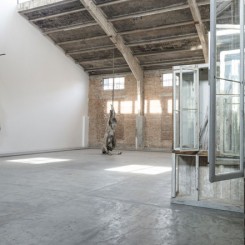Berlinde de Bruyckere solo exhibition
Galleria Continua (Dashanzi Art District 798 #8503, 2 Jiuxianqiao Road, Chaoyang, Beijing) Dec 22, 2012 – Mar 17, 2013
Berlinde de Bruyckere’s sculpture seems to create its own level. The artist for an earlier exhibition (“We are all Flesh” at the Australian Centre for Contemporary Art last year) explained imagining the high-ceilinged space like a church, a sensation undiminished in the chancel-like cavity of Galleria Continua in Beijing where several sculptures now hang, or stand. In the light-flooded lower area is a trinity of works – spare in its possession of space but in other ways disarming in extent – two entitled “We Are All Flesh” (2011-2012) are made from dead horses (one hangs from the focal wall); the other is a large open cabinet holding waxen branches.
The works in this exhibition lie somewhere between the real and a purgatory of form; horses’ bodies have been taken apart and sewn together by hand to make a strange, headless animal-object. Where once was recognizable power and muscle hangs an alien bulk — its legs stiff, its weight awkwardly channeled in inert directions. An idea of purgatory stems from the way in which these bodies have been punished, but also purified through a creative process. Theirs is an oscillating state of de-formed and form, which is somehow majestic in the final sum. An allusion to purgatory is appropriate, too, to the environment in which de Bruckere works and from which she draws deliberate influence, steeped in the religious iconography of Ghent’s alter pieces and Old Masters. In the Chinese context, however, such associations are cast adrift; one wonders what might be felt in their place.

BERLINDE DE BRUYCKERE, Galleria Continua / Beijing, gallery view
(courtesy: Galleria Continua, San Gimignano / Beijing / Le Moulin
photo by: Oak Taylor-Smith)
The exhibition increases in delicacy as one ascends to the upper floors. Leaving heft and hide below, one encounters a room lined with what de Bruyckere calls “portraits”; this “Rodt” series (2012) is comprised of clusters of antlers facing downward. Hung from small metal meat hooks and cast in wax with a whitish-pink color, they are grotesque and vulnerable, as if peeled. Their still-cruel points rendered in fleshy tones seem simultaneously to imply aggression and injury, as if the weapon had absorbed and begun to exude, irrevocably, its own painful effects. This quality of being fused, as the horses are physically, pervades de Bruyckere’s practice, evoking at once the relief, compulsion and confinement of human relationships. In the next room, a raft of these antlers, tangled with branches and small sacks, lies upon a decrepit wooden table like an altar — a visual metaphor for the death of Actaeon, after which the work (of 2012) is named.

BERLINDE DE BRUYCKERE, “Actaeon (Beijing) , 2012,” wax, wood, epoxy, iron, textile, H140 x 83 x 105 cm, 2012 (courtesy: Galleria Continua, San Gimignano / Beijing / Le Moulin photo by: Oak Taylor-Smith)
The final work in the exhibition, alone in the small upper room, is the only one which overtly indicates the human body. Lying on a cushion supported by a small wall-mounted wooden platform is a corporeal fragment: “Verbinding” (meaning “connection” or “binding,” 2009). Mottled and grey as if in death this strange, limbless, recumbent thing is not unlike a carcass, placed perhaps as if to test our impulses to find flesh and blood — mere matter and form, in fact. It is the final boundary these works tread.
Such is the encounter with this powerful solo exhibition. These are sculptures of real formal power, yet whose lasting impact transcends their materials. Sculpture is an art of presence, and in this regard, de Bruyckere’s practice weighs in heavily.

